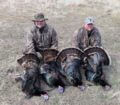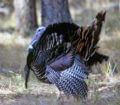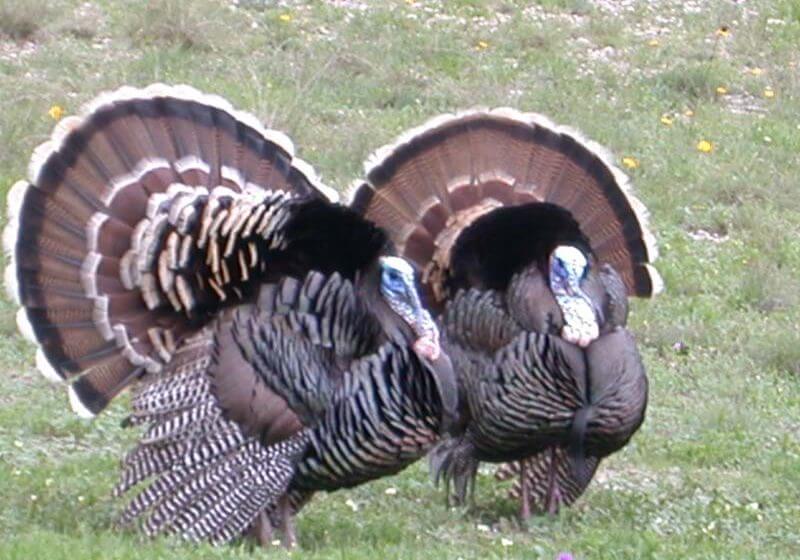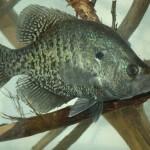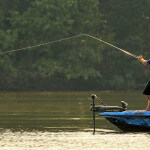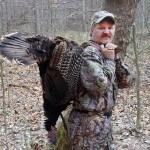Editor’s Note: Chris Phillips of Novi, Michigan has been chasing gobblers for 40+ years and hunts private land in five states. Over the years, he’s built a network of people who give him access to prime turkey-hunting property. He hunts about 5,000 acres in Nebraska, 12,000 in Mississippi, 10,000 in Kansas, 2,000 in Missouri and 2,000 in Michigan for a total of 31,000 acres.
 In Nebraska, we hunt Merriam’s gobblers. We found a flock of 400 Merriams that broke off into smaller groups, and then we hunted the smaller groups of turkeys, taking them as soon as they flew down off their roost. We slipped in to within 50 yards of those birds and set-up our decoy spread and blind before daylight. One gobbler flew into our decoy spread, and my hunting partner took that gobbler with his bow. The rest of the turkeys then flew the opposite direction from our blind. We caught up with the birds feeding along the edge of a strip of privet hedge in a large field.
In Nebraska, we hunt Merriam’s gobblers. We found a flock of 400 Merriams that broke off into smaller groups, and then we hunted the smaller groups of turkeys, taking them as soon as they flew down off their roost. We slipped in to within 50 yards of those birds and set-up our decoy spread and blind before daylight. One gobbler flew into our decoy spread, and my hunting partner took that gobbler with his bow. The rest of the turkeys then flew the opposite direction from our blind. We caught up with the birds feeding along the edge of a strip of privet hedge in a large field.
 We gave up our bows, picked up our shotguns and went to the back side of the privet hedges. I took a stand on one end of the long row of privet, and my buddy set-up on the opposite end. We were hunting early in the season right after a snow in cold and windy weather. I just had backed up against a pine tree wearing my full camouflage plus a face mask and gloves. I was absolutely invisible. Finally I saw eight longbeards break out of the flock and start coming to me. I gave those turkeys some soft calling, letting them know I was a hen looking for a boyfriend. Once those eight toms came strolling along in front of me, I shot two of them. In Nebraska, you can take three gobblers at any time during the season. I texted my buddy at the other end of the privet hedge that I had taken two gobblers. He texted me back that he had bagged a gobbler at his end of the private hedge. So, we harvested four turkeys the first morning we hunted Nebraska.
We gave up our bows, picked up our shotguns and went to the back side of the privet hedges. I took a stand on one end of the long row of privet, and my buddy set-up on the opposite end. We were hunting early in the season right after a snow in cold and windy weather. I just had backed up against a pine tree wearing my full camouflage plus a face mask and gloves. I was absolutely invisible. Finally I saw eight longbeards break out of the flock and start coming to me. I gave those turkeys some soft calling, letting them know I was a hen looking for a boyfriend. Once those eight toms came strolling along in front of me, I shot two of them. In Nebraska, you can take three gobblers at any time during the season. I texted my buddy at the other end of the privet hedge that I had taken two gobblers. He texted me back that he had bagged a gobbler at his end of the private hedge. So, we harvested four turkeys the first morning we hunted Nebraska.
 The Merriam’s tom has a different sound to his gobble, and instead of sounding like he’s choking, the Merriam’s seem to roll his gobble out. Too, Merriam’s gobblers can be like Rios and come in hard-charging. But in the middle of their runs to the call, they may hang up and start to act like eastern gobblers. When they leave the roost, Merriam’s seem to know where they’re going every day. They’re relatively easy to pattern. You can set-up a blind, not even have to call to them and take them when they come down the same trail they always walk when they leave the roost.
The Merriam’s tom has a different sound to his gobble, and instead of sounding like he’s choking, the Merriam’s seem to roll his gobble out. Too, Merriam’s gobblers can be like Rios and come in hard-charging. But in the middle of their runs to the call, they may hang up and start to act like eastern gobblers. When they leave the roost, Merriam’s seem to know where they’re going every day. They’re relatively easy to pattern. You can set-up a blind, not even have to call to them and take them when they come down the same trail they always walk when they leave the roost.
In the country I hunt, the Merriam’s have very-few places to roost. So, they all have to roost in the same trees, typically in shelter belts. When the wind starts blowing like it often does there, the turkeys may just hang out in those shelter belts all day long. When the wind is blowing, these birds can be difficult to hunt, because they can see you coming.
To learn more about turkey hunting, check out John E. Phillips’ print, Audible and Kindle turkey books at https://johninthewild.com/books/#turkey. For a free copy of John E. Phillips’ “The Turkey Gobbler Getter Manual,” go to https://johninthewild.com/free-books/.

